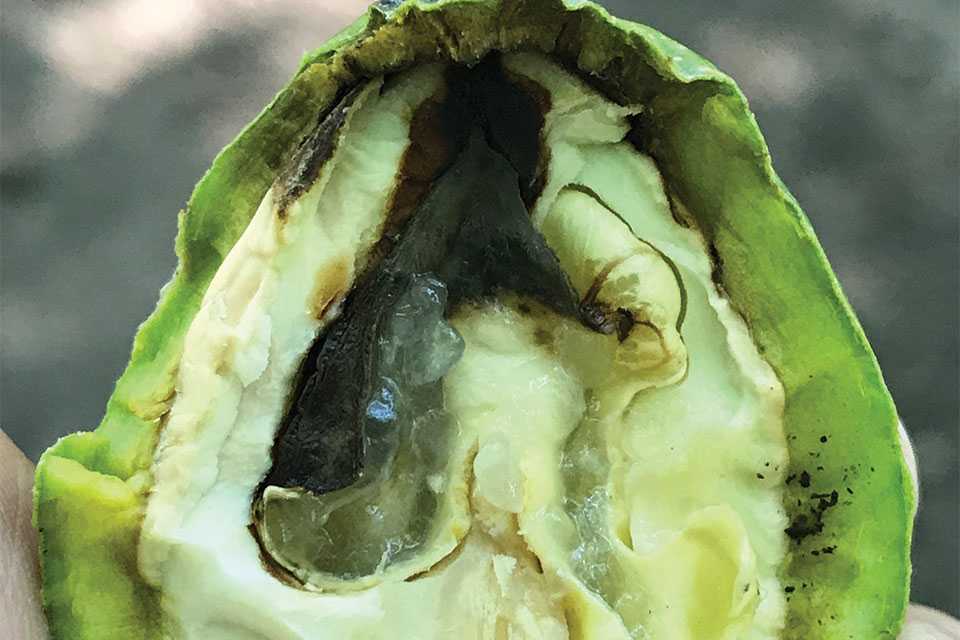New Crop Protection Tool in Walnut Blight Fight

Here is an up-close look at an “end blight” dropped walnut, blighted at the flower end and with evidence of the infection killing the developing kernel.
Photo by Luke Milliron
For many, 2017 will be remembered as a tough year for walnut blight. A long, wet spring meant conditions were ideal for Xanthomonas arboricola pv. juglandis (Xaj), the bacterium that causes walnut blight. If there was ever a time when a new tool to manage this viciously destructive disease would be especially welcomed, it would be now, as many orchards head into the 2018 season with a tremendous amount of overwintering disease inoculum.
A new tool in the fight against walnut blight, Kasumin 2L (kasugamycin) was federally registered March 1. Kasumin 2L was expected to be approved in California in March when the walnut label went through a final hurdle with the state’s Department of Pesticide Regulation in time to be available for the upcoming walnut blight season. Kasugamycin has been in the regulatory pipeline for more than 11 years, in part because of its classification by the EPA as an antibiotic.
What does kasugamycin offer walnut growers facing a perennial fight with blight? Dr. Jim Adaskaveg, Plant Pathology Professor at University of California, Riverside, has found Kasumin 2L to have excellent and consistent efficacy when applied with either copper (e.g., Champion++, Kocide 3000, Badge X2, etc.) or mancozeb (e.g., Manzate, Dithane). However, kasugamycin is not a silver bullet. Used alone, kasugamycin has more moderate efficacy and is at an elevated risk for Xaj resistance development.
The introduction of kasugamycin opens a new chapter in walnut blight management because of the opportunity to finally rotate chemistries. Kasumin 2L used in combination with copper (Cu) or with mancozeb, as well as the current industry standard of Cu-mancozeb, can be used to form a three-part rotation. Dr. Adaskaveg found the Cu-mancozeb, kasugamycin-mancozeb, kasugamycin-Cu rotation to be highly effective. These two material rotations work well because each of the chemistries has a different mode of action (MOA) in targeting bacteria, denoted by the FRAC group M1 for copper, M3 for mancozeb, and 24 for kasugamycin. Note: To satisfy the label for mancozeb, a kasugamycin-mancozeb application may also need to include some level of copper material. Always closely follow pesticide labels.
Using Kasumin 2L
When growers use Kasumin 2L, it will be important to carefully follow its labeled use and restrictions. The labeled rate is 64 fluid ounces (fl oz) per acre with a minimum of 100 gallons of water by ground rig, with no off-label use rates. No application by air is permitted. You must have a sufficient volume of spray to attain good coverage, with a reduced spray volume possible on small trees. Once available, only two applications of Kasumin 2L will be allowed in the 2018 season.
Upon further environmental toxicology documentation, four annual applications (a total of 256 fl oz, or four applications x 64 fl /oz per application) may be allowed in future years. If four applications are possible in future years, Kasumin 2L may only be used in a maximum of two applications consecutively. There will also be a minimum interval of seven days between applications. In addition, alternate row spraying will not be allowed with Kasumin 2L. These restrictions are aimed at reducing the risk of resistance development.
Other restrictions include a pre-harvest interval (PHI) of 100 days, which may be around the middle or end of June depending on the walnut variety. Finally, some additional restrictions are specific to its classification as an antibiotic (reducing exposure to non-target bacteria), such as prohibiting its use in orchards with animal grazing or fertilization from animal manure sources. As with any pesticide, it’s critical to carefully read and follow the labeled use. In 2018, introducing one or two applications of kasugamycin paired with copper or mancozeb will allow you to add rotation and resistance management into your blight management program.
Management Fundamentals
Kasugamycin is a highly effective spray partner with copper and with mancozeb. However, the material applied is only a single component in the management program of any pest or disease that requires spray application as a part of its integrated management.
If the fundamentals of spray timing, rate, and coverage are not adhered to, the best materials will do little to control this tenacious disease capable of prolific spread and significant economic impact.
For more information on the fundamentals of walnut blight management, visit http://www.sacvalleyorchards.com/walnuts/diseases/walnut-blight-management.
Walnut blight can spread rapidly, and spray materials represent only a single part of the fight against the disease. However, it is also true that the copper-mancozeb (or maneb) combination has been the only thing keeping the walnut industry in the fight against blight for nearly 27 years.
If the effectiveness of the copper-mancozeb combination was lost due to resistance, it would be an incredibly tough hit to the industry, particularly in the Northern Sacramento Valley. A third efficacious bactericide allows the industry to open a new chapter in the fight against walnut blight, one where we can finally rotate modes of action and preserve the effectiveness of copper-mancozeb for many years to come.
The authors of this article and the UC Agriculture and Natural Resources do not prescribe or recommend the application of any pesticide or other agrichemical.









